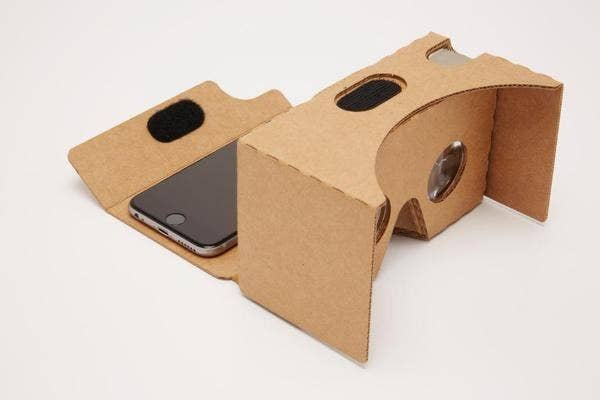
In professional sports, it is a truism that building a team via the minor leagues, the draft, and cheap, undervalued free agents is better than building a team by hiring superstars. The former method is inexpensive, sustainable, and leads to a coherent organizational culture. The latter, by contrast, is expensive, often unsustainable, and can lead to a mercenary and incoherent organizational culture. Though win/loss columns do contain examples to the contrary, any sports fan will tell you building cheap and from within is the way to go. It's Moneyball versus the Yankees.
That seems to be the approach to virtual reality Google outlined today at its annual I/O developer's conference, which clarified several things about the tech world's never-ending sprint towards "immersive experiences." Most prominently, Google's initiative stands in sharp relief to the swaggering and slightly mercenary VR strategy of their greatest rival in the nascent space, Facebook.
Cardboard, Google's low-cost VR headset, was conceived in-house by employees taking advantage of the company's fabled "20 percent time". It's cheap. You can make it yourself. And it takes advantage of existing players we carry around with us daily — smartphones. Google's new Expeditions program, also announced today, is going to put Cardboard in the hands of thousands of school-kids -- seeding a next-generation audience for the company's VR efforts. And with Jump, a technology for creating virtual reality footage, Google is crowd-sourcing VR content development. There's a partnership with GoPro, sure, but it's limited; anyone can make the camera rig if they want to.
Then, there's Facebook's Oculus. That VR effort was conceived out-of-house. It cost Facebook $2 billion dollars to acquire. Rift, the VR headset developed by Oculus, can't be put together at home. And it's going to cost $1500 -- an exorbitant price that will surely be too high for the kids who will most want to use it. And despite Facebook's best efforts to spin Rift as a device that will further the company's mission of social connectivity, it still seems like a gaming luxury device, at best. And the content, well, who knows what the content is going to look like? We're assured some of the entertainment industry's finest minds are involved.
None of this is to say that Cardboard and Jump are destined to succeed and Oculus is doomed to fail. One or two transcendent acquisitions have lifted certain teams to titles, and a similarly transformative piece of software could do the same for Oculus. But Google's approach is building a structure for a culture of virtual reality — the kids who use Expedition this fall will someday be adults who know what a VR experience should feel like. Facebook simply bought superlative technology from without and is hoping for the best.
And as any Lakers fan can tell you, when your big buys don't work out, you're screwed.
Of course, Facebook has the money to hold onto Oculus for years, and technology owned by companies with billions never has to retire. Down the road, Oculus founder Palmer Luckey and Facebook CEO Mark Zuckerberg may look back on the day Google decided to put VR in classrooms with fondness; what many VR enthusiasts still don't understand is that the creation of a virtual reality culture is as important a prerequisite to its sustainable popularity as good technology. That's an area where Oculus has done little -- and where Google just announced two major strides. So don't be surprised if the killer Oculus app is built by an artist or a designer inspired by seeing Jump footage for the first time.
Because, come to think of it, before you focus on building a good team, you should make sure people care about the sport.
